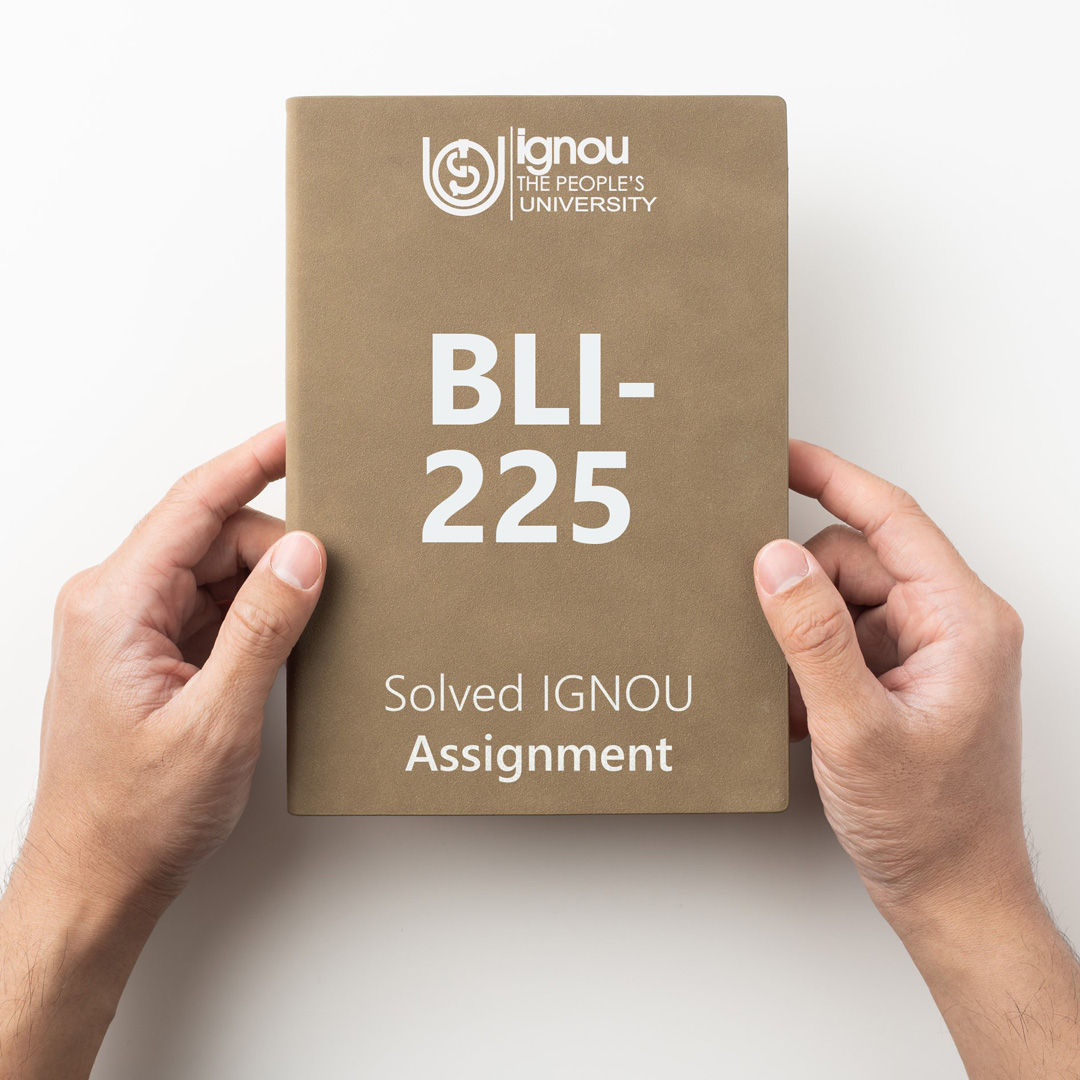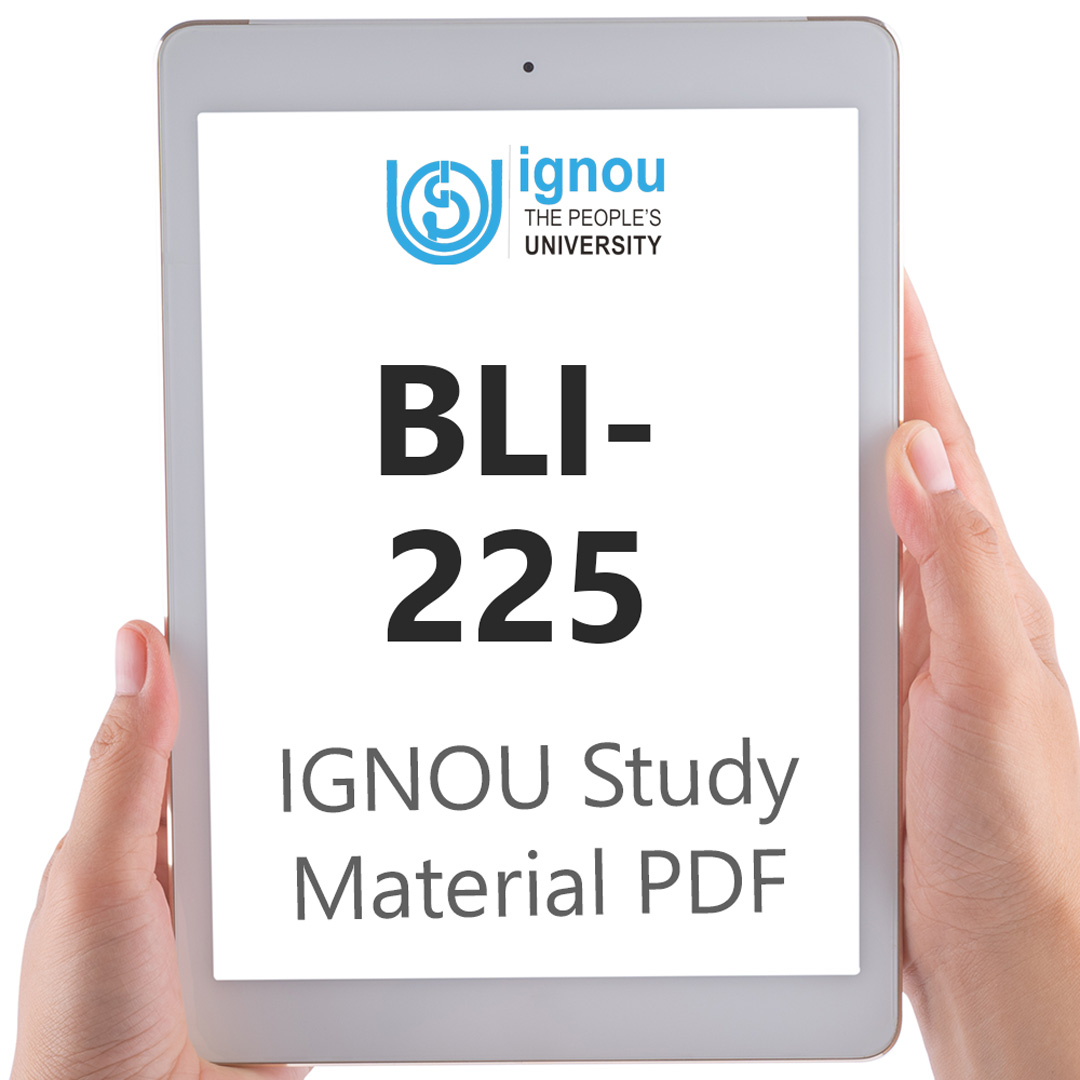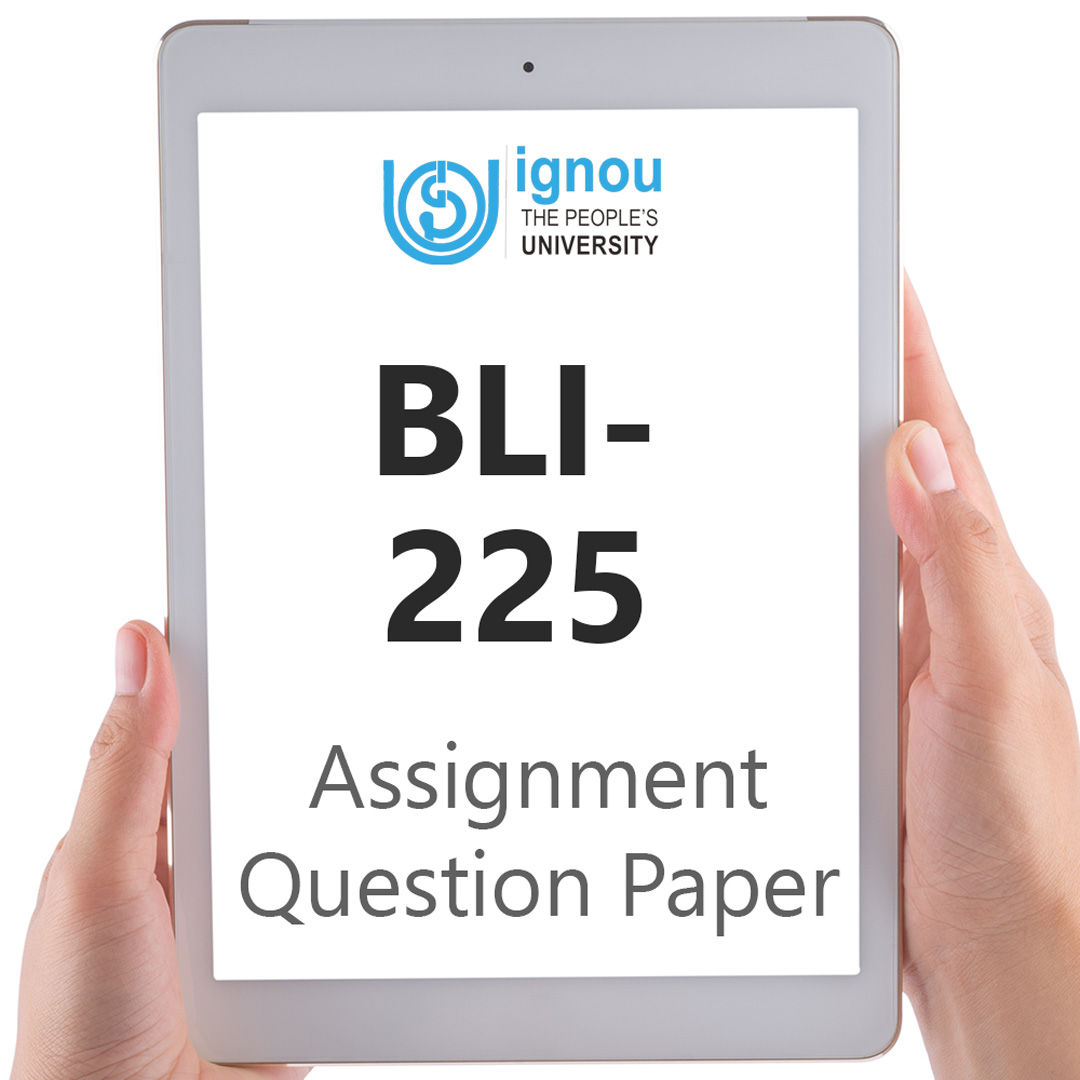If you are looking for BLI-225 IGNOU Solved Assignment solution for the subject Communication Skills, you have come to the right place. BLI-225 solution on this page applies to 2022-23 session students studying in BLIS courses of IGNOU.
BLI-225 Solved Assignment Solution by Gyaniversity
Assignment Code: BLI-225/AST-1/TMA/Jul.22-Jan.23
Course Code: BLI-225
Assignment Name: Communication Skills
Year: 2022-2023
Verification Status: Verified by Professor
Total Marks: 70
Note: Answer all questions.
1. Read the passage carefully and answer the questions given below. (2X10= 20 Marks)
Language, as we have seen, seems to be a highly developed form of animal signaling. But there is a missing link in the chain. How, and when, did we start to talk? This is a problem of interest mainly to ethologists (students of animal behavior), and one which has not yet been solved. Most linguists regard this fascinating topic as being outside the realm of linguistics proper. They are more interested in studying actual language than in speculating about its origins. But although how language began is a puzzle, why language began seems rather clearer. Possibly it began because humans needed a greater degree of cooperation with each other in order to survive, and this cooperation required efficient communication.
Consequently, the primary function of language is to impart factual information and to convey essential commands. But language can also be used to communicate feelings and emotions. This aspect of language is not as well developed as “information talking‟, because humans, like other primates, can convey emotions by screams, grunts, sobs, gestures and so on. So, they need language only to confirm and elaborate these more primitive signals. In addition, there is the language of social chitchat, the meaningless small talk of everyday life. “Hallo, how nice to see you. How are you? Isn’t the weather terrible?” This social patter has been called phatic communion and is primarily a device to maintain social contact on a friendly level. Some ethnologists call it “grooming talking‟ and suggest that it is substitute for the friendly grooming indulged in by the monkeys. There are other biologically less important functions of language. Humans may use language for purely aesthetic reasons. In writing poetry, for example, people manipulate words in the same way as they might model clay or paint a picture. Or they may talk in order to release nervous tension, a function seen when people mutter to themselves in anger and frustration.
1.1.a) Say whether the following statements are true or false according to the passage. Correct the false statements. (10)
i) Language is a highly sophisticated form of human sign communication.
Ans) False. Language seems to be a highly developed form of animal signaling.
ii) Ethnologists are interested in the study of animal behavior.
Ans) True.
iii) How language began is obscure.
Ans) False. Although how language began is a puzzle, why language began seems rather clearer.
iv) The main function of language is to convey emotions and feelings.
Ans) False. The primary/main function of language is to impart factual information and to convey essential commands.
v) Phatic communication is similar to “groom talking‟ of monkeys.
Ans) True.
1.2.b) Answer the following questions: (10)
i) List four reasons why human need to “talk‟?
Ans) The four reasons why human need to “talk‟ are as follows:
To impart factual information and to convey essential commands.
For social chitchat, the meaningless small talk of everyday life.
To convey emotions by screams, grunts, sobs, gestures and so on.
To release nervous tension, a function seen when people mutter to themselves in anger and frustration.
ii) Besides “talk‟ how else do humans convey emotions?
Ans) Humans can convey emotions by screams, grunts, sobs, gestures and so on.
iii) What is phatic communication? Give your own example of phatic communication.
Ans) Phatic communication is verbal or non-verbal communication that has a social function, such as to start a conversation, greet someone, or say goodbye, rather than an informative function. Learners sometimes find it difficult to recognise phatic communication.
Example: Waving hello is non-verbal phatic communication and saying, ‘How's it going?' is verbal.
iv) What is the primary function of writing?
Ans) The primary function of writing to express oneself, to provide information, to persuade, or to create a literary work.
v) Give an appropriate title to the passage.
Ans) Title: Essentials of Communication.
2. Explain the different types of communication. (10)
Ans) The different types of communication are as follows:
Verbal Communication: Verbal communication encompasses all communication using spoken words, or unspoken words as in the case with sign language. It is important to understand how to effectively communicate your ideas verbally in order to avoid misunderstandings and maximize interest while you speak. Make sure to use the right type of language, speak clearly, know your audience, respond in the best way, and use an appropriate tone when speaking.
Nonverbal Communication: What is actually being said is only half the battle — the rest lies in what isn’t being said. This means your tone, facial expressions, body language, hand movements, and eye contact. When you make yourself aware of what the rest of you is doing as you speak, you can make corrections and eventually use all the right nonverbal cues to convey your point.
Written Communication: Written communication is a form of verbal communication, but it is so different than spoken verbal communication that this form gets its own separate type. Written communication can take the form of anything you write or type such as letters, emails, notes, texts, billboards, even a message written in the sky! With written communication, it is important you know your audience, your purpose, and maintain consistency throughout your written message.
Visual Communication: Visual communication is one you may not have heard of, but it is one that complements the other types of communication well. Visual communication is delivering information, messages, and points by way of graphical representations, or visual aids. Some commonly used examples are slide presentations, diagrams, physical models, drawings, and illustrations. When you use visual communication in addition to verbal, nonverbal, and written communication, you create a very effective way for your message to be heard and understood.
Listening: Listening is a surprisingly important part of communication and in order to be a great communicator, you must master the art of listening. Remember that listening doesn’t just mean hearing, or politely waiting for your turn to speak. When others are speaking, you should practice active listening, which means that you are engaging your mind while the person speaks, intently focusing on what they are saying.
3. Describe the different barriers to listening. (10)
Ans) The different barriers to listening are as follows:
Judgment of the speaker or the topic. Do you find yourself pulled away from the conversation in front of you and focused on your own perspective about the person speaking to you or your feelings about the topic?
Getting ready to speak or thinking about your counterargument. Listening is more than waiting for your turn to talk, yet many of us can get distracted by planning what we will say next.
Distraction or daydreaming. Is your attention pulled toward people walking by, thinking about what meeting you have next or email alerts popping up on your screen?
Connecting to what the other person is saying and making it about you. Perhaps you hear the challenge the other person is bringing to you and it reminds you so much of a situation you have faced that you put all of your attention on what you did to resolve the challenge.
Making assumptions or reading the mind of the speaker. Are you guilty of hearing a few words of the other person’s question and assuming you understand what they are asking without letting them finish?
Giving advice or counsel and believing you know the answer. Do you find yourself solving everything others bring to you rather than hearing if they even wanted to you what you would do in their position?
Agreeing just to stop or avoid the conversation. Have you found yourself weary of the conversation you are in and agreeing with the other person only to be able to end the conversation?
Looking through your ‘lens’ or filter (attitude, belief or experience) and only hearing the parts you want to. Some of us fall prey to making whatever the other person brings up about us without recognizing that we can’t possibly know what the other person’s experience of this situation is unless we ask them.
Getting into a debate or sparring match. Do you love to debate any issue? You might fall pretty to debating or sparring for the sake of entertaining yourself versus hearing what the other person is saying.
Comparison and evaluation of what the other person is saying relative to you. It has been said comparison is the thief of joy. If you fall victim to this barrier you may be failing to fully listen and getting distracted with what you did or did not do in similar situations.
4. Prepare a presentation with at least 10 slides on any one of the following topics. (10)
a) Telephonic skills
Ans) Presentation is attached in the PPT file.
5. Write on any two of the given topics in about 100 words. (10)
b) Writing skills
Ans) Writing skills are the skills you use to write effectively and succinctly. A good writer is someone who can communicate their point to their audience without using too much fluff and in a way that the other person can understand. Writing skills don’t just include the physical act of writing. Skills like research, planning and outlining, editing, revising, spelling and grammar, and organization are critical components of the writing process.
In the workplace, writing skills examples include:
Documenting a process for someone else to learn it
Summarizing a meeting in an email for all attendees
Sharing a team update in Slack
Crafting a mass email to send to prospective customers
Communicating with a client via email to get action on next steps
c) Preparing your Portfolio
Ans) First, look at yourself the way the prospective employers would look at you. Your portfolio should have everything in it that would impress the employer. The folder/binder, the contents, the organisation of the contents, accuracy, style, relevance of the contents, etc. should reflect your personality. Give meticulous attention to everything in the portfolio: spelling, grammar, language, style.
The items selected for the portfolio should showcase your skills and competencies and the relevance of these to the job in question. These should be the very best of your achievements. Start by developing a portfolio “collection” that contains all of your artifacts. Include whatever you have achieved, written, developed, created, earned. The format of these collected items could be a printout, a photograph, a photocopy, or in digital format, or any other.
The items could include anything such as the following:
Articles written by you or about you
Awards /recognitions received by you
Drawings made by you
Educational qualifications, copies of certificates etc.
Letters of commendation
Letters of reference
Appropriate photographs
Presentations, if any made by you
Training certificates.
6. Write a letter to the prime minister of India requesting him for free COVID-19 vaccination for all the citizens of India. (10)
Ans)
May 12, 2021
Dear Mr Prime Minister,
The Covid-19 pandemic in our country has assumed unprecedented dimensions of a human catastrophe.
We have repeatedly in the past drawn your attention, independently and jointly, to the various measures that are absolutely imperative for the government to undertake and implement. Unfortunately, the government has either ignored or refused all these suggestions. This only compounded the situation to reach such an apocalyptic human tragedy. Without going into all the acts of commission and omission by the government that have brought the country to such a tragic pass, we are of the firm opinion that the following measures must be undertaken on a war footing by the government.
Procure vaccines centrally from all available sources - global and domestic.
Immediately begin a free, universal mass vaccination campaign across the country.
Invoke compulsory licensing to expand domestic vaccine production.
Spend budgetary allocation of Rs. 35,000 crores for the vaccines.
Stop Central Vista construction. Use the allocated money for procuring oxygen and vaccines, instead.
Release all money held in the unaccounted private trust fund, PM Cares to buy more vaccines, Oxygen and medical equipment required.
Give all jobless at least Rs. 6000 per month.
Free distribution of foodgrains to the needy (over one crore tonnes of food-grains are currently rotting in central godown).
Repeal farm laws to protect lakhs of our annadatas becoming victims of the pandemic so that they can continue to produce food to feed the Indian people.
Though it has not been the practice of your office or government, we would appreciate a response to our suggestions in the interests of India and our people.
Respectfully,
ABC.






